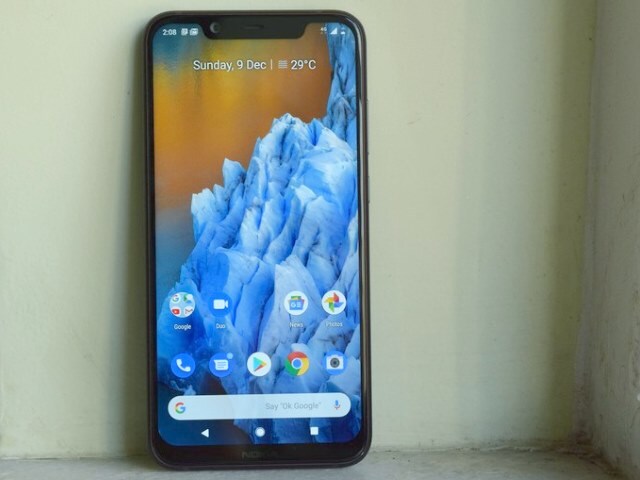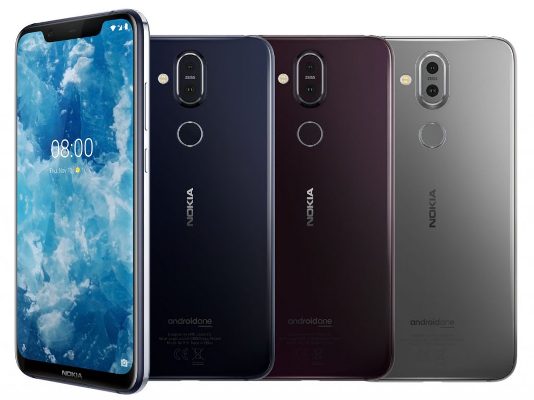HIGHLIGHTS
- The Nokia 8.1 has a 6.18-inch display with a notch, and a 3500mAh battery
- This is an Android One phone that’s already running Android 9.0 Pie
- It uses the new octa-core Snapdragon 710 SoC and has 4GB of RAM
As if HMD Global’s number-and-decimal model hierarchy wasn’t confusing enough, there has been a course correction with the Nokia 8.1. This phone is not in any way meant to be superior to last year’s flagship Nokia 8₹ 25,990 or the Nokia 8 Sirocco₹ 34,400 — from now on, flagship models will almost certainly make up a new 9-series tier. Instead, the new Nokia 8.1 is a premium model for those who don’t want to spend flagship-level money. Sure enough, there is a fairly wide gap in the market right now because thanks to relentless price wars, we now have a lot of sub-Rs. 20,000 phones with features that were considered impossible to find at that level just about a year ago.
However, the prices of premium phones have been coming down as well. We have the very strong Poco F1₹ 19,999 (Review) and Asus ZenFone 5Z (Review), as well as Samsung’s triple-camera Galaxy A7 (Review), which tempt buyers in the sub-Rs. 30,000 bracket with flagship-grade features. Has HMD Global judged the market correctly, and can the new Nokia 8.1 find its footing here? We’re about to find out.
Nokia 8.1 design
The Nokia 8.1 feels big, chunky, and heavy thanks to the materials and styling that HMD Global has gone with. The body is made of solid aluminium with glass on the front and rear. You have a choice of two colours — Blue/ Silver and Iron/ Steel — both of which have contrasting metal accents. Our review unit is the Iron version, which is more of a very deep plum purple, and is quite unusual. There’s a thick, flat band of highly polished steel running all around the sides. Visually, the band emphasises this phone’s 7.97mm thickness by splitting the body and interrupting the smooth curve of the sides. There are similarly shiny accents around camera bump and fingerprint sensor on the back.
On the positive side, the Nokia 8.1 is built like a tank. Every part of it feels completely solid, right down to the thick metal SIM tray and the power and volume buttons. The body doesn’t twist or flex even slightly. The glass on the front is an unspecified version of Corning Gorilla Glass, and HMD Global hasn’t confirmed whether the back is reinforced as well. Water and dust resistance would have been nice, but there doesn’t seem to be any IPxx rating.
The display notch is quite wide, and the earpiece, front camera, front flash, and proximity sensor are accommodated inside it. The chin isn’t too thick, but a reflective Nokia logo draws the eye there. On the back, the camera module bulges outward far more than what we’ve become used to seeing on phones like the OnePlus 6T. When lying on its back, the Nokia 8.1 rests on the camera bump and the glass surface barely makes contact with whatever is beneath it, which actually helps prevent it from sliding around.
Despite its proportions, the Nokia 8.1 is easy enough to grip. We were able to use it with one hand in some situations without worrying that it might slip and fall. Overall, while the material quality as well as the fit and finish of the Nokia 8.1 are excellent, it isn’t as slick or modern as some of its competitors.
Nokia 8.1 specifications and software
The most interesting thing about the Nokia 8.1 is that it isn’t meant to succeed the Nokia 8 (Review) or Nokia 8 Sirocco (Review), both of which were flagship devices using the once-flagship Qualcomm Snapdragon 835 processor. Instead, what we have is our first phone running the new Snapdragon 710, which is still meant to be premium, but not quite top-of-the-line. Qualcomm introduced the new 7xx series to address the fact that Snapdragon 6xx SoCs are now common in sub-Rs. 20,000 phones, leaving a huge gap between that level and the sole Snapdragon 8xx model of each generation.
The Snapdragon 710 supports high-end smartphone features with a dedicated AI subsystem, support for multiple high-resolution cameras, modern LTE modem, and of course beefy CPU and GPU cores. There are eight custom Kryo 360 CPU cores, but there’s a twist that the spec sheet isn’t clear about — two of these are Kryo 360 Gold cores (ARM Cortex-A75) running at up to 2.2GHz, and six are Kryo 360 Silver (ARM Cortex-A55) running at 1.7GHz. The Adreno 616 GPU is also claimed to deliver “console-like” gaming quality.
Another highlight of this phone is its HDR10-capable screen. It measures 6.18 inches from corner to corner and has an unusual 18.7:9 aspect ratio, which makes the resolution 1080×2246. There’s a 3500mAh battery, and “18W fast charging” is supported and you get a big 18W charger in the box, though HMD Global isn’t using the Qualcomm Quick Charge name.
There’s only one configuration option for the Nokia 8.1, with 4GB of RAM and 64GB of storage. That seems a little stingy, considering that 128GB is not uncommon at this price level. You can pop in a microSD card, but that means sacrificing a second SIM thanks to the hybrid dual-SIM design. Speaking of SIMs, 4G and VoLTE are supported on both. You also get Wi-Fi 802.11ac, Bluetooth 5, NFC, FM radio, and GPS. There’s a USB Type-C port on the bottom and a 3.5mm audio jack on the top.
Our review unit was already running Android 9.0 Pie when we first took it out of its sealed box. This is an Android One phone, which means you get the stock Android UI and you’re guaranteed regular and quick security updates as well as major version updates for at least two years. We did notice a few minor UI customisations including forced icon outlines on the home screens and in the app drawer — you can choose between several shapes, but you can’t just let icons be. Our unit had the new Android 9.0 gestures enabled by default instead of standard navigation buttons. We find this to be a little frustrating to use, but at least it can be reverted, unlike on Google’s Pixel 3 phones. To do so, you have to find the Gestures section in the Settings app and then uncheck ‘Swipe up on Home button’.
Thanks to the wide notch, the only way to see your battery level percentage is to have tiny numbers within the battery icon, or pull down the notifications shade. The numbers in the icon are only visible if you squint, which means you lose this important glanceable information. If you want to mask the notch with a black band, you’ll have to dig through the hidden Developer panel in the Settings app and check ‘Full Bezel’. This will apply system-wide, not per-app.
There are a few display presets so you can choose standard, vivid, or muted colours. The default is Dynamic, which changes the preset depending on what you’re doing. An Ambient Display feature shows the time, date, and notification icons in monochrome, and you can tap to take an action when you get an incoming message. The Ambient Display can stay on while the phone is charging, but it isn’t on all the time otherwise because this isn’t an AMOLED panel.
Preloaded software is limited to Google’s own apps including Google Pay (formerly Google Tez) and a Nokia Care support app. Once you start using Google Assistant and tying in your Google services, you’ll see “At a glance” information on the home screens, including traffic alerts and upcoming calendar events. There’s a lot to be said for the snappiness of the stock Android experience, but you don’t get other useful features such as the ability to run multiple instances of some apps or a secure area for hidden files and apps.
Nokia 8.1 performance, battery life, and cameras
We were curious to put the brand new Snapdragon 710 SoC through its paces with all our usual benchmarks. Starting with AnTuTu, we got a score of 1,71,343. Geekbench’s single-core and multi-core tests gave us 1,827 and 5,867 respectively, and Basemark Web 3.0 returned 222.09 points. On the graphics front, we got 57fps in GFXBench’s T-rex test and 22fps in the Manhattan 3.1 test. These scores show a reasonable bump in performance compared to, say, the Snapdragon 660 or MediaTek Helio P60, more so in graphics quality than CPU strength. We’re still nowhere near what the Snapdragon 845 can pump out, though.
In terms of real-world usage, the experience was predictably smooth throughout our review period. Phones with much lower-tier processors these days function without stuttering, and so we were not disappointed. We were able to switch between apps and multiple Chrome browser tabs without any stress. PUBG and Asphalt 9: Legends were perfectly smooth as well. Asphalt 9 defaulted to its medium quality preset but worked fine after we bumped that up, and PUBG ran at its high framerate and quality presets from the start.
The HDR screen jumped to life when we tried some YouTube demo videos. Even if the resolution drops down to 480p or so, you can watch videos with HDR and there are no modes or settings to worry about. HDR videos look particularly good because of how close you generally hold a smartphone to your face, as long as you push the brightness up. Of course, this will stress the battery, and we noticed a drop of about 2 percent after watching five or six minutes of HDR video at 1080p. You can’t override HDR on a system-wide level if you want to turn it off, though. Sound through the single mono speaker is very loud and is not too harsh or tinny.
That brings us to battery life, which wasn’t terribly exciting. After a full day of use including about two hours of non-HDR video streaming and a few rounds of PUBG, plus the usual messaging and Web browsing, we found that the Nokia 8.1 was down to about 10 percent by the time we went to bed at night. Our HD video loop test ran for just 9 hours, 21 minutes.
The Nokia 8.1 has a 12-megapixel primary rear camera with a Zeiss-branded lens, and optical image stabilisation along with a secondary 13-megapixel fixed-focus depth sensor. Nokia hasn’t published the aperture values, but touts the primary camera’s “super-sensitive” 1/2.55-inch sensor with 1.4-micron pixels. There’s a 20-megapixel front camera with an adaptive mode that combines four pixels to capture better detail in low light at the expense of resolution.
The camera app is fairly busy, with a row of eight icons at the top to give you quick access to lots of features and the detailed Settings menu. A ribbon of modes runs across the bottom, letting you select Square, Panorama, Live Bokeh, Pro, Auto Photo, Video, Slow Motion, and Time-lapse. You can also trigger the Pro mode by dragging the shutter release button upwards. If you’ve used high-end Nokia phones in the past, you’ll recognise the concentric rings that can be slid around to change various settings. On a phone this large, it can be difficult to reach all the settings while holding the camera up to frame a shot.




Tap to see full-sized Nokia 8.1 camera samples
Photo quality was good, but not especially consistent. Many of our daytime samples had very good detail and vibrant colours. The Nokia 8.1 was quick to lock focus and was fun to use. There was a bit of overexposure in some shots, and bright parts of the sky would get blown out easily. It took a little while to make sure focus was in the right spot for Live Bokeh shots, but they came out looking great.
At night however, quality took a nosedive. Shots were generally quite bright, but there was way too much noise, and details were grainy. Distant objects couldn’t be made out well, and even when shots looked passable on the phone itself, we saw that the focus was sometimes completely wrong when we reviewed our photos on a big screen later.
Videos taken in the daytime were crisp and sharp. Optical image stabilisation definitely made a difference at the default 1920×1080 recording resolution. Even as we walked on an uneven pavement, footage came out looking pretty smooth. At night, there was a weird throbbing effect in our sample videos, and they were far shakier and blurrier.
The front camera was pretty good in most situations, including in the dark. You can choose to overlay shots taken with the front and rear cameras simultaneously, either side by side or picture-in-picture. Beautification is available and off by default.

Nokia 8.1 in pictures
Verdict
The Nokia 8.1 is a confusingly named phone. We aren’t judging it by its predecessors, but it’s hard to say exactly where this phone fits because it doesn’t offer any flagship-class features, but doesn’t fit into a value-conscious price bracket either. If you want to spend around Rs. 30,000, there are more powerful options such as the Asus ZenFone 5Z and Poco F1. On the other hand, there are several models that cost well under Rs. 20,000 and deliver a similar level of performance — including the new Nokia 7.1 (Review).
This phone can be seen as an upgrade over the usual low-cost options in terms of its material and construction quality, style, display, and cameras – the latter in the daytime, at least. Some users might also be willing to pay a little more for the Nokia name. There is a lot to like about the Nokia 8.1, but most of the things that give it its appeal can also be found in phones that cost much less.





































